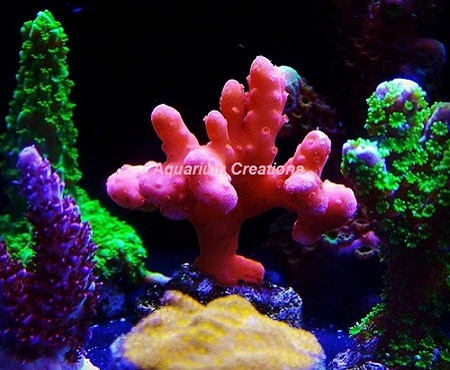Description:
ORA® Captive Grown Acropora Packages are available in 3, 6 or 9 or 12 packs of beautiful acropora, combined to give you a great variety of both color and species. One very important point to consider when purchasing this package is that these acropora are not just mounted frags. Think of ORA's Captive grown (also called Aquacultured) Acropora as Baby SPS acro's all sized between 1-1/2 and 3 inches and are all mounted on 1/2 inch diameter plugs. Aquacultured corals such as offered by ORA are the future of the reef aquarium hobby. All of our ORA Acropora packages contain pure aquacultured specimens, many generations removed from the original wild starter colonies. No tissue or skeleton of the wild specimen remain. All are third, fourth, fifth and even older generations. We have hundreds of very colorful ORA Acro's available. Acropora chosen are grown and are never sold until they are truly ready. When you purchase any of our ORA Captive Grown Acropora Pack's you will receive either 3, 6, 9 or 12 acropora. We hand select all your pieces, so we are very sure you will be happy with our choices.
Difficulty Moderate
Aggressiveness Peaceful
Water-flow
Requires moderate to high water flow
Lighting
Requires bright lighting (PAR 350-500) to maintain its color. T5's, Metal Halides, or LED's can all grow acropora when the proper PAR levels are provided. We recommend a 14-20K color spectrum for best coloration.
Placement
.DO NOT CUT THE ACROPORA FROM THE MOUNT AT THIS TIME. After about 4 weeks in your reef aquarium, your new Acro's should be adjusted to your tank. Then you may carefully mount your SPS using IC gel glue, or putty, on an exposed rock or ledge in the aquarium where it still will receive direct flow and light. Make sure the mounting location is in the same area as your Acropora was prior to mounting so the conditions are the same.
Diet and Feeding
All your SPS corals will be happier when they are fed. The mouth sizes for each polyp is relative to the body size of the polyp and this size will more or less determine the particle size a coral can eat. We have found that even the smallest of SPS polyps, even Anacropora will accept food. There are several coral foods available to the aquarium hobbyist and we generally mix up a few with varying particle sizes and target feed this to all of our corals. We've had success feeding all our corals and find our Echinophyllia (chalice corals) Montiporas, Acroporas especially A. millepora among others respond well to feeding. When you are feeding your corals you will want to turn off the flow in your tank and gently target each coral. We like to feed our corals at the end of the day when the lights are still on their daytime light setting. You can even try broadcasting some food in the tank before you target feed as a "dinner bell" for your corals, or try polyp lab reef booster as a way to prepare your corals to feed. We recommend feeding your corals several times per week. After a few days of feeding your corals should be responding quicker to your dinner bell and looking all and all more vibrant. Some of the benefits we have noticed after 2-3 week included more polyp extension, puffier body tissue, more colourful, increased growth (compared to unfed corals). Excellent SPS Cora food include Phyto Feast, Oyster Feast, Roti Feast, Phyto Plankton, Zoo Plankton, Marine Snow, Coral Frenzy, Cyclops. We also always recommend target feeding since it gets the corals fed using less food while keeping your nitrates and phosphates lower.
Water Chemistry
It is important that the proper calcium (420-440 ppm), alkalinity (8-9.5 dkh - run it 7-8 if you are carbon dosing) , and magnesium levels (1260-1350 ppm) are all maintained. Raising magnesium levels gradually up to 1400-1600 ppm is a great help in combating algae outbreaks, just keep Calcium and alkalinity levels where they should be as you raise the Magnesium level. Try to keep Nitrate levels below 10 ppm, Phosphate levels below .10 ppm. We recommend doing frequent water changes to keep Nitrate levels below 10 ppm. If Phosphate numbers are above the .10 ppm level, change your phosphate control media. To make the most efficient use of your phosphate media, we recommend the use of a media reactor.
|



